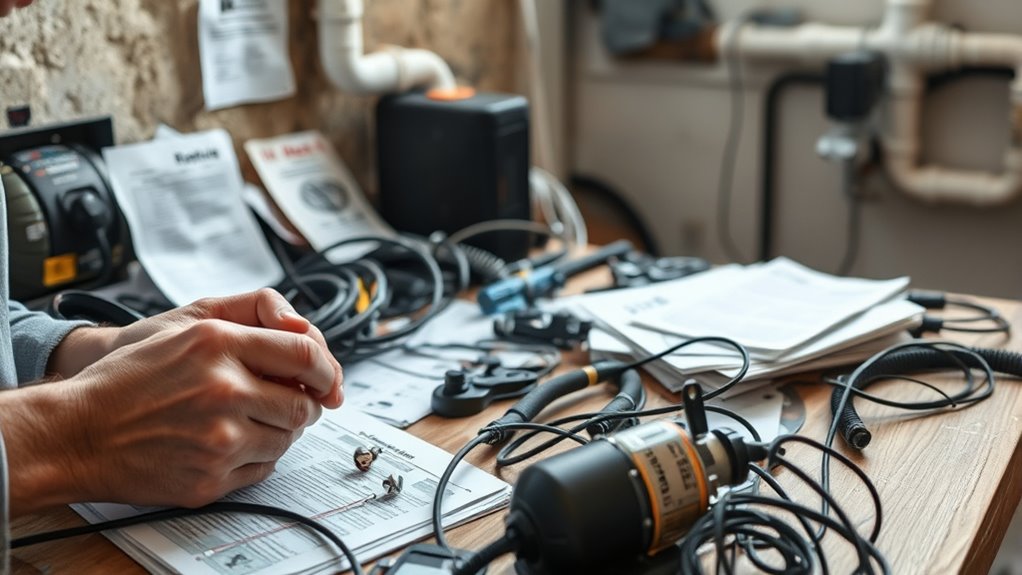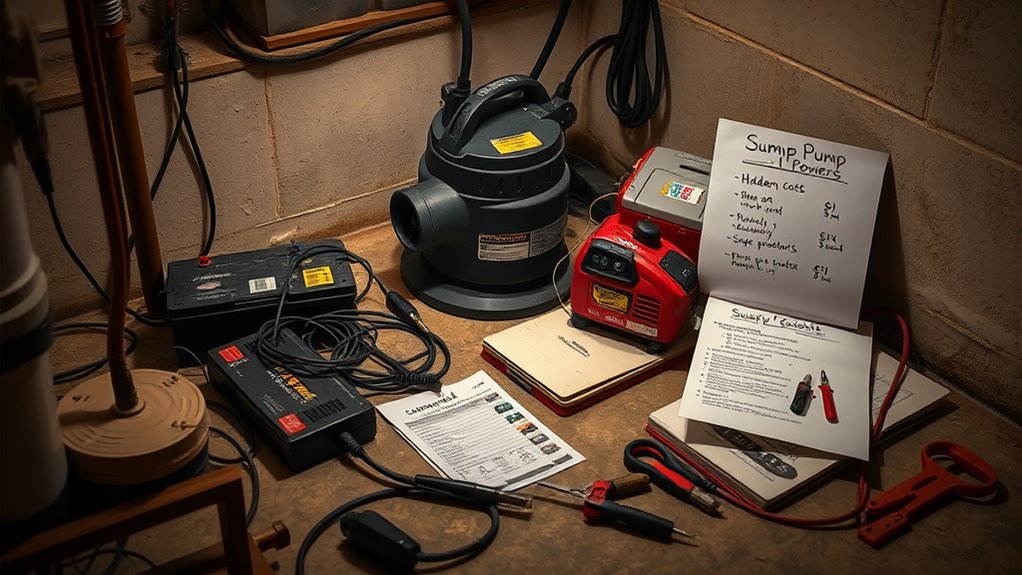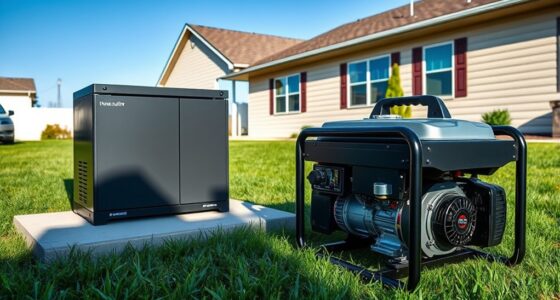To avoid hidden costs with sump pump backup options, you need to plan for installation and setup fees, regular maintenance, and unexpected repairs. Budget for battery replacements, emergency power expenses, and potential monitoring or alarm fees. Don’t forget to verify your insurance and warranty coverage to prevent surprises later on. Being aware of these factors helps you save money and ensures your system stays reliable during storms—learn more to protect your investment.
Key Takeaways
- Account for installation and setup costs, including professional services and backup securing, to prevent unexpected expenses.
- Regularly budget for maintenance, battery replacements, and generator fuel to avoid costly failures during storms.
- Anticipate repair costs for mechanical failures like clogged pipes or failing backup pumps through proactive inspections.
- Review warranty and insurance policies carefully to identify coverage gaps and avoid out-of-pocket repair costs.
- Monitor ongoing expenses such as alarm subscriptions and service fees to prevent budget overruns over system lifespan.
Installation and Setup Expenses

Installing a sump pump backup system involves several costs that you should consider upfront. One major expense is the installation itself, which can vary depending on your home’s setup. To save money, look into cost-effective alternatives like DIY installation, but ensure you follow professional installation tips to avoid mistakes that could lead to costly repairs later. Hiring a professional may seem like an added expense, but it ensures the system is correctly installed and functions reliably. Proper setup includes securing the backup unit, connecting it properly to your existing sump pump, and ensuring proper power sources. Additionally, understanding the backup system options available can help you choose the most reliable and cost-effective solution for your needs. Budgeting for these installation costs upfront helps you avoid surprises and guarantees your sump pump backup system offers dependable protection during heavy rain or power outages.
Regular Maintenance and Inspection Costs

Regular maintenance and inspections are essential to keep your sump pump working smoothly. You’ll need to determine how often to check it and how much these inspections will cost. Staying on top of the timing and expenses can help prevent costly backups later on. Incorporating routine calibration can also improve the pump’s performance and extend its lifespan.
Maintenance Frequency Needs
To guarantee your sump pump functions properly during heavy rains, you need to perform regular maintenance and inspections. The frequency depends on your backup system type, especially if you have an alternative backup. Regular checks help ensure system durability by catching wear or potential failures early. For backup options like batteries or generators, maintenance might be needed more often to prevent unexpected breakdowns. Consistent inspections also verify that switches, alarms, and power sources are operational. Skipping routine maintenance can lead to costly failures when you need your backup most. Set a schedule based on manufacturer recommendations and your system’s complexity. Staying proactive with maintenance minimizes the risk of backup failure when storms hit, saving you money and stress during critical moments. Additionally, understanding industry transformations such as AI automation can help you adopt smarter maintenance tools, further reducing potential failures.
Inspection Costs and Timing
Scheduling regular inspections for your sump pump backup system helps catch potential issues early and avoids costly repairs. Proper inspection timing guarantees you identify problems before they escalate, saving you money in the long run. A cost-effective evaluation involves checking the system’s components, testing pumps, and verifying backup power sources. Regular inspections, ideally annually or after severe weather, prevent unexpected failures during storms. This proactive approach minimizes emergency repairs and extends the lifespan of your system. Keep detailed records of each inspection to track performance and identify recurring issues. Staying on top of inspection costs and timing not only ensures your sump pump backup remains reliable but also helps you budget effectively by avoiding unnecessary expenses.
Battery Replacement and Maintenance

Your sump pump battery typically lasts three to five years, so regular checks are vital. Maintenance involves cleaning terminals and testing the backup system to guarantee reliability. Replacement costs can vary, but staying on top of these needs helps prevent costly failures during storms. Embracing the importance of regular maintenance can ensure your system functions optimally when needed most.
Battery Lifespan Expectations
Battery lifespan expectations vary depending on the type and usage of your sump pump backup system. Over time, battery degradation reduces its capacity, making lifespan estimation more uncertain. On average, batteries last 3 to 5 years, but harsh conditions or frequent use can shorten this. You should regularly monitor your battery’s health to avoid unexpected failures during storms. To help you understand the emotional impact of these costs, consider this table:
| Time Remaining | Battery Condition | Emotional Impact |
|---|---|---|
| 1 Year | Excellent | Confidence, peace |
| 3 Years | Fair | Anxiety, concern |
| 5+ Years | Poor | Frustration, worry |
Knowing these expectations helps you prepare for timely replacements, avoiding sudden backup failures. Additionally, investing in advanced security systems can help protect your backup systems from cyber threats that could lead to malfunctions.
Maintenance and Replacement Costs
Regular maintenance and timely replacements are essential to guarantee your sump pump backup system functions reliably during emergencies. Neglecting these can lead to costly failures when you need backup most. To keep costs low and ensure long-term savings, schedule regular inspections and replace batteries before they fail. Consider these cost-effective solutions:
- Checking battery water levels monthly
- Cleaning battery terminals to prevent corrosion
- Testing backup systems quarterly
- Replacing batteries every 3-5 years
- Investing in high-quality, durable batteries
- Monitoring backup system performance regularly to catch issues early
Staying proactive minimizes unexpected expenses and extends the lifespan of your backup system. Proper maintenance may seem like an added cost, but it ultimately saves you money by preventing major repairs or system failures during critical moments. Consistent upkeep ensures reliability and helps you avoid unnecessary expenses down the line.
Emergency Power Source Expenses

When a sump pump backup relies on an emergency power source, the expenses can add up quickly. Investing in a generator involves considering its efficiency; a less efficient model will consume more fuel, increasing ongoing costs. You also need to account for potential power surge risks, which can damage the generator or your sump system, leading to costly repairs. Some generators require regular maintenance, adding to the overall expense. Additionally, if you opt for a larger or more advanced generator, upfront costs rise. Keep in mind that running the generator during outages can considerably raise your utility bills. To avoid unexpected expenses, choose a generator with good efficiency ratings and consider surge protection options to safeguard your equipment while managing long-term costs effectively.
Unexpected Repairs and Part Replacements

Unexpected repairs and part replacements can catch you off guard, especially if your sump pump backup system isn’t well-maintained. Costly part failures often lead to emergency fixes, which can be expensive. You might face unexpected repair costs from worn-out components or sudden malfunction. These issues can disrupt your home’s protection and strain your budget. To minimize surprises, watch out for:
Unexpected sump pump repairs can disrupt your home and drain your budget—stay vigilant with regular maintenance.
- Worn-out batteries or power supplies
- Faulty float switches
- Damaged check valves
- Corroded or clogged discharge pipes
- Failing backup pumps
Staying proactive with regular inspections reduces the risk of costly part failures. Additionally, understanding the maintenance requirements of your backup system can help prevent unexpected breakdowns. However, even with diligent maintenance, unexpected repairs can happen. Preparing for these surprises ensures you’re not caught unprepared when your sump pump backup system needs quick attention.
Monitoring System and Alarm Fees

Monitoring system and alarm fees can add a significant, ongoing expense to your sump pump backup setup. If you choose a system that requires an alarm subscription, you’ll need to budget for monthly monitoring fees, which can vary widely depending on the provider. These fees cover the cost of professional monitoring services that alert you if your sump pump fails or if water levels rise dangerously. While some systems may include free monitoring, others charge monthly fees that can add up over time. Keep in mind that these costs are ongoing and can increase if you upgrade or add features. Regularly reviewing your merchant services options can help you find more cost-effective solutions. To avoid surprises, compare providers carefully and consider whether the peace of mind is worth the extra expense.
Insurance and Warranty Considerations

Insurance and warranty options play a crucial role in protecting your investment in a sump pump backup system. However, be aware of potential pitfalls like policy exclusions and warranty limitations that could leave you uncovered during a backup failure. To maximize your coverage, check if your policy specifically includes sump pump issues and understand any exclusions. Similarly, read the warranty fine print to know what’s covered and what’s not. Consider these points:
- Verify if policy exclusions apply to backup system damage
- Clarify warranty limitations on labor and parts
- Ensure coverage extends to power outages or flooding
- Confirm if extended warranties are available
- Review claim procedures to avoid surprises during emergencies
- Understanding the importance of insurance and warranty coverage helps prevent unexpected costs and ensures your backup system remains protected when you need it most.
Frequently Asked Questions
Are There Hidden Costs Associated With Sump Pump Backup System Upgrades?
Yes, there are hidden costs when upgrading your sump pump backup system. You might face ongoing maintenance expenses to keep the system in top shape and avoid failures. Additionally, warranty coverage can be limited or add extra costs if repairs are needed. Be sure to review warranty terms and budget for regular maintenance to prevent unexpected expenses down the line. This way, you can avoid costly surprises later.
How Much Can Unexpected System Failures Cost Unexpectedly?
Unexpected system failures can cost you big time, sometimes thousands of dollars. A proper cost estimation and risk assessment help you prepare for these surprises. If your sump pump backup fails during a storm, you might face water damage repairs, mold removal, and increased insurance claims—all adding up quickly. Don’t put all your eggs in one basket; planning ahead minimizes financial shocks and keeps your home safe when you need it most.
Do Some Backup Options Require Specialized Professional Installation?
Yes, some backup options require professional installation because they involve specialized equipment. For example, installing a battery backup sump pump or a generator backup often needs expert help to guarantee proper setup and safety. Without professional installation, you risk improper functioning, potential damage, or voided warranties. Investing in qualified installation helps you avoid costly mistakes, guarantees reliable operation, and ensures your backup system provides protection when you need it most.
What Are the Long-Term Costs of Different Backup System Types?
Think of your backup system as a garden needing steady care. With a cost comparison, you see that battery backups have lower initial costs but higher maintenance expenses over time, while generators demand bigger upfront investments but lower ongoing costs. You’ll want to weigh these against reliability and lifespan, ensuring your choice balances long-term expenses with consistent performance. Regular maintenance keeps your investment healthy, preventing costly surprises.
Are There Additional Fees for System Monitoring Beyond Initial Setup?
Yes, there can be additional fees for system monitoring beyond initial setup. You might face ongoing maintenance fees or service charges from your provider, especially if they offer remote monitoring or regular checkups. These costs guarantee your backup system stays reliable but can add up over time. Always ask about any extra charges upfront, so you’re not caught off guard by unexpected maintenance fees or service charges later on.
Conclusion
Being aware of these hidden costs helps you make smarter choices for your sump pump backup. By planning ahead and staying vigilant, you can avoid unexpected surprises that may quietly drain your resources. Think of it as tending a garden—you nurture it carefully to keep everything flourishing. With a little foresight, you’ll create a reliable safety net that protects your home without any unwelcome surprises, giving you peace of mind when you need it most.









